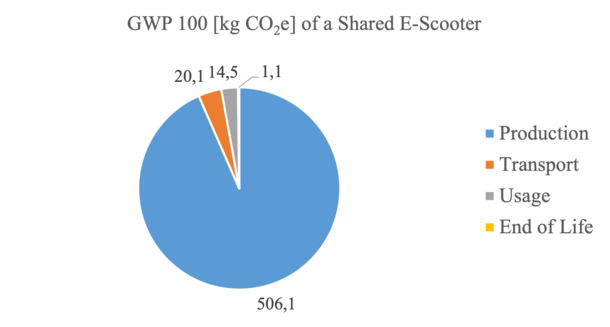Screening LCA E-Scooter Sharing Update
Overview
E-scooters are currently in the focus of public interest and are controversially discussed as a new mobility alternative. Due to the rapid growth of the market for e-scooter sharing worldwide, the question of environmental sustainability and the advantages for urban mobility systems has been raised. In cooperation with a European sharing service operator, we conducted a screening life cycle analysis (LCA) for e-scooter sharing services as an update of our previous LCA [1] reflecting a European average. The aim was to objectify the discourse on e-scooters and to develop recommendations for action to improve the greenhouse gas balance and maximize CO2 savings. The ecological potential of e-scooters must be evaluated in a more differentiated way on the basis of different operating scenarios.
The term e-scooter
The so-called e-scooters are driven standing up, are approved for speeds of up to 20 km/h and are therefore specially designed for use by individuals on short distances in urban environments. While e-scooters have been in use for years in the USA or China, for example, they have only been approved for use on German roads since the Small Electric Vehicle Ordinance (eKFV) came into force in June 2019.
Procedure
The study uses Life Cycle Assessment (LCA) methodology to quantify the global impact of e-scooter sharing services on the Global Warming Potential (GWP100). The most important basis of a life cycle analysis is the collection of data. As a data basis for modelling the production phase, we analysed a bill of materials (BoM) and disassembled and weighted individual parts. The data was then integrated into an LCA model.
For the use phase, we also collected data using a survey. Here is a selection of the questions we asked:
- Which scooter model is used?
- Where are the scooters produced?
- How are the scooters transported to the place of operation?
- What is the lifetime of the scooters?
- How are the e-scooters charged?
- How are the batteries collected? With diesel vans, e-vans or with cargo e-bikes?
- How long is the service life of the batteries
- With which mix of electricy are scooters charged?
As a result of our surveys, we made the following assumptions:
| Parameter | Assumption | Unit |
|---|---|---|
| Production site | China | |
| Electricity demand for the production of one scooter | 3.5 | kWh |
| Electric mix production | CN electricity mix | |
| GWP electricity mix manufacturing CN | 0.836 | kgCO2e/kWh |
| Share of secondary aluminium | 20 | % |
| Distance of transport | 12,000 | km |
| Mode of transport* | 12% truck (Euro 6) and 72% rail (mix of diesel and electric), 11% ship, 5% cargo plane | |
| Range scooter | 53 | km |
| Energy demand/ km | 0.013 | kWh/km |
| Average daily distance scooter | 10.2 | km |
| Scooter lifetime | 38.5 | months |
| Average distance scooter/lifetime | 11,877 | km |
| Number of batteries per scooter lifetime* | 1,35 | piece |
| GWP EU Green electricity mix from wind for charging | 0.009 | kgCO2e/kWh |
| GWP EU electricity mix for recycling | 0.395 | kgCO2e/kWh |
| Method of energy supply | Battery swapping | |
| GWP of diesel van for battery swapping | 0.236 | kgCO2e/km |
| GWP of e-van for battery swapping | 0.064 | kgCO2e/km |
| GWP of e-bike for battery swapping | 0.034 | kgCO2e/km |
| Distance of service e-van/ scooter and day* | 0.325 | km |
| Distance of service cargo bike/ scooter and day* | 0.1125 | km |
| Distance of service e-van/ scooter lifetime* | 382 | km |
| Distance of e-bike/ scooter lifetime* | 132 | km |
| Share of e-van* | 43.0 | % |
| Share of e-bike* | 57.0 | % |
| Energy Consumption End of Life | 2.7 | kWh |
* Update 06/2021
Main results and discussion
As a result, the total lifecycle impact of a shared e-scooter using European boundary conditions is 548 kg CO2e and 46 g CO2e / passenger km. Below we depict the shares of the different phases, respectively.
The result presented is a considerable improvement compared to our previous studies. This is mainly because the lifetime of a scooter increased significantly from 24 months to 38.5 months and the usage of green electricity to charge the scooters, according to data provided by the sharing operator.
It is worth noting that this study is a screening LCA where we covered the most relevant factors. Some data e.g. long term experiences about the usage and new parts in the bill of materials may lead to a change of results. Also, the ecological potential of e-scooters must be evaluated in a more differentiated way based on different operating scenarios within a full LCA study including a sensitivity analysis and further recommendations.
Previous study:
[1] S. Severengiz, S. Finke, N. Schelte, and N. Wendt, “Life Cycle Assessment on the Mobility Service E-Scooter Sharing,” in 2020 IEEE European Technology and Engineering Management Summit (E-TEMS), Dortmund, Germany, Mar. 2020, pp. 1–6, doi: 10.1109/ETEMS46250.2020.9111817
available at: https://ieeexplore.ieee.org/document/9111817


